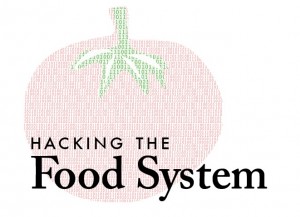[Due to the overwhelming response to our series Hacking the Food System, Food+Tech Connect will be continuing the conversation each Wednesday with a new post from a thought leader in the field. Read past posts exploring how technology, information and data can change the food system status quo and follow along as the conversation continues on Twitter (hashtag #foodtech), or Facebook.]

It’s an exciting time for the emerging food tech movement. There has been an explosion of apps, websites and platforms designed to re-connect urban dwellers with farmers and local foods, to create community around urban farming activity, and to make attempts to lift the veil of the food system here in the U.S. All of this hacking activity holds the promise of helping to create a more open, transparent and connected food system.
Yet I would venture that the potential sum total end-users of this connected universe as we currently envision it is quite small; perhaps a few million people, mainly early adopter, educated LOHAS demographic customers living in cities who have the luxury of understanding, owning and using technology in a highly self-selected mode of participation.
The question I propose is this: While hacking and re-imagining the food system here in the U.S., can we interact with, learn from and collaborate with like-minds on a global scale to meet the needs of growing populations in a resource constrained world?
In broad strokes, a commonly accepted figure is that, around the world, there are about 2.5 billion people at the so-called bottom-of-the-pyramid, living in poverty, many in a state of illness, hunger or starvation. Of those, maybe a billion are also subsistence farmers, tending small plots of land. That figure alone is roughly three times the size of the entire population of the United States.
The other oft-repeated statistic these days is that over 50% of the world now lives in cities. A related but less sexy projection is that one third of those people live in informal settlements, and by 2050 it is estimated that 50% of the world’s population will live in slums. The definitions of “cities”, “slums” and the relationship and borders between them also begs definition, but for the sake of argument, this means roughly 3 to 4.5 billion people will live in slums in 2050 based on population projections. How can we think about hacking the food system to meet the needs of this population? And further, are there things we can learn from these populations to help inform our own vision of a connected food system?
The connection between global agricultural data, ecosystem services and the feeding of a growing population is increasingly a focus for world governing bodies, humanitarian NGOs, technology companies and even investment banks and speculators. Ambitious real-time GIS dashboards, such as the Cisco backed Planetary Skin, proactive humanitarian data mining initiatives like UN Global Pulse, and various grass-roots participatory mapping and sensor projects together have the potential to paint a picture of the strains on global, regional and local ecosystems and natural resources that traditional agriculture depends upon. Combined with shifting climate, extreme weather and the vulnerability of informal settlements and slums, a larger picture of the complexity of feeding the world emerges.
While technology is hailed as a means to liberate and connect and create openness and communication, by the same power it is inherently tied to the relentless march towards ruthless efficiency, engineering and wealth creation. While I think that the traditional farmer will persist, globally food production and food systems will be subject to a kind of Moore’s Law of high-tech efficiency. One could even argue that the activity of splicing DNA and developing “traits” in GMO seeds by biotech labs at the biggest food conglomerates could be considered “using information and technology to hack the food system”. The thought makes many people shudder.
In some ways, in the developed world we are stuck in a dysfunctional limbo between a “technolust” for the ability of apps, data and technology to enable a better food system and the old fashioned way we’d like our food grown, ideally by rugged and good looking farmers. While the image of the bucolic, organic farmer is a charming vision of local, regional food production, technology may in fact displace traditional notions of agriculture that we cherish, in favor of necessary efficiencies. In a resource-constrained world, this may in fact be the most ecological, equitable and restorative pathway to reduce energy and water use.
In the developing world, the technology that is perhaps most effectively hacking the food system is the adoption of ultra low-cost entrepreneurial farming equipment. One of the most successful of these systems is the “Moneymaker,” an inexpensive pump that has revolutionized the yields of subsistence farmers in Africa and other countries. These kind of low-cost, low-tech interventions, often sold in peer-to-peer market situations are in fact one of the singularly most powerful ways to combat poverty and global hunger.
While these kinds of low-tech, word-of-mouth innovations are promising in the near term, the global shift towards industrial agriculture continues to alter the lives and livelihoods of the rural poor. Many displaced farmers migrate to informal settlements and slums of nearby cities to look for non-agricultural work. The dramatic numbers of people migrating to megacities (as many as hundreds an hour in some cities in Africa and India), is placing a dramatic strain on local resources and infrastructure. The swirl of subsidies, policy failures and corruption in the global industrial food market which are often the cause of this are the subject of much discussion, but ultimately it is a failure of government. Like in most failures of government, an opportunity arises for an open source solution.
Many promising mobile and ICT initiatives are emerging that harness the power of open source software and low cost cell phone equipment to help connect poor rural farmers with the information and tools they need to be more effective. One of these, the Grameen Foundations Applab uses the Android platform to provide upated information on rain, crops, seeds, market prices, cooperative models and harvesting to farmers connected by community.
In conclusion, I’d like to believe that smart use of technology can facilitate programs to keep healthy rural farming economies alive globally, while at the same time creating a more holistic picture of biogeographic data to allow governments to manage the rural/urban interface and connected food systems more effectively. While we consider the technologies that we are using to hack the food system here in the U.S., let’s expand our imagination and vision to understand how we can hack the food systems of an increasingly crowded and resource constrained world.
_____________
Marc Alt is a design leader who has dedicated his career to connecting design, technology and ecology. He has been an advisor to companies such as BMW, MINI USA and Ogilvy Earth and is actively involved in a number of urban mobility and smart cities initiatives. Marc lectures internationally and presents workshops on living systems, resiliency, ecological design and ancestral knowledge. He is editor and founder of Open Source Cities, an idea marketplace for the future of cities.






